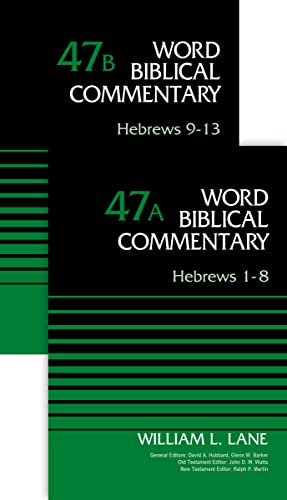Hebrews (Word Biblical Commentary) (2 vols)
Written by William L. Lane Reviewed By John LewisWilliam L. Lane’s shorter commentary on this epistle, Hebrews: A Call to Commitment (Nashville: Thomas Nelson, 1985), emphasized the pastoral nature of Hebrews by picturing how the text was addressing the real-life concerns of a distressed body in the early church, thus providing eminently practical applications for the life of the church today. This latest commentary includes more of the same but with fleshed-out exposition of key themes and texts as well as keen technical scholarship. Lane does not abandon his commitment to the pastoral nature of Hebrews nor its timeless worth to the church, and his research demonstrates significant interaction with the text itself and the contributions of other scholars in this area.
In the introduction, Lane wisely refuses to speculate about the writer other than particular characteristics which can be inferred from the text itself. His position on the recipients, a small house church in Rome prior to Neronian persecution, remains unchanged from his first commentary. His analysis of the literary structure and the use of the OT are particularly worthy of attention. The complexity of the development of themes, in addition to the lack of clear transitional statements in the letter, makes structural divisions difficult to determine with certainty. Lane’s discussion, while technical, provides a valuable overview of the problem. Particularly beneficial are his comments on the use of transitional devices which give Hebrews its unique flow. Since Lane often refers to the utilization of such devices within the body of the text, it is helpful to have read the introductory comments beforehand. The same is true concerning Lane’s comments on the writer’s manner of appropriating the OT text, particularly the principles which are involved in quoting and interpreting different texts.
The body of the commentary is well written and goes beyond mere essentials. Extensive bibliographies precede each section, greatly benefitting those who desire further research. I also found the textual notes which follow each translation to be ample and exegetically sound, with many good interactions with other scholars on difficult matters. Furthermore, Lane has not ignored the artistry of the Greek text itself. Throughout the commentary he points out the biblical writer’s literary techniques so that one may grasp not only the text’s message but also the skilful style which is so distinctive of Hebrews.
I generally found Lane’s comments on difficult texts to be well researched and insightful. For example, he fails to find any evidence for the proposal that the biblical writer is addressing a heretical practice of angel worship in the opening chapters. Instead, he notes the positive role as covenant mediators assigned to angels in 2:2 and the omission of any polemic with regard to angels throughout the book as an argument against such speculation. His treatment of the issue of Melchizedek is also soundly based in the text and not in speculative proposals. In 9:15–17, Lane uniformly translates diathēkē as ‘covenant’ and argues well that it means the symbolic ratification of a covenant rather than the administration of a will. On the basis of linguistic and stylistic parallels he effectively demonstrates continuity and integrity between the body of the homily and the concluding exhortations of chapter 13.
Lane interprets 5:7 as a reference to the entirety of Jesus’ high-priestly service and not simply to the agony experienced by Christ at Gethsemane. He bases this upon a contrast with the character of the Levitical high priest in 4:15 and 5:1, yet he fails to demonstrate why his interpretation is preferable to the one held by many, that 5:7–8 depicts Jesus’ sufferings from Gethsemane until his death. More interaction with the alternative understanding would have been helpful here.
Lane’s treatment of 6:4–6 is the most disappointing aspect of the entire commentary. The doctrine of perseverance is a significant one, and this text is pivotal for one’s decision as to whether or not salvation can be lost. Lane believes that it can, and he methodically dissects the text to demonstrate his understanding of the apostasy depicted here as one in which a person who has been genuinely converted rejects Christ and falls away. To Lane’s credit, he maintains that the text is indicating a real possibility and not merely a hypothetical one, and he also remains consistent with the text that in such a case a second repentance is emphatically declared impossible. Yet his position in the matter is not the issue here; the reader is free to agree or to disagree. My concern is that there is no direct interaction with the alternative viewpoint or scriptural passages which appear to contradict the possibility of his conclusion. In a commentary of this scope one would expect a reasonable amount of involvement with these issues, but regrettably there is none.
Despite this, Lane’s work is a tremendous accomplishment. If I were to possess but one commentary on Hebrews, this would be my choice. His achievement is evident in the wealth of information offered, his close attention to detail, and his commitment to extracting the fullest measure of the message of the text. The evangelical professor, student and pastor will appreciate his efforts the most, but the depth of his scholarship will appeal to a wide range of readers.
John Lewis
John Lewis
Southeastern Baptist Theological Seminary
Wake Forest, North Carolina, USA







